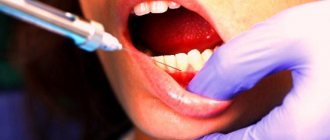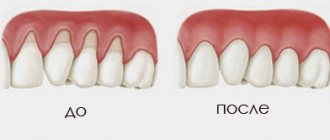Unbearable toothache, sore gums and bad breath require urgent attention from a dentist so as not to aggravate an existing problem.
The initial appointment is carried out by dental therapists. This is a sought-after specialization, since these doctors treat common pathologies of the gums, teeth and oral tissues. A general dentist has a broader range of expertise than a highly specialized orthodontist or surgeon. Such dentists eliminate periodontitis and periodontal disease, relieve pathological changes in the functioning of the salivary glands, treat cheilitis and glossitis (inflammation of the lips and tongue)
A dental therapist not only fills root canals, treats gums or removes tartar. A dentist works to study problems in the maxillofacial area and develop new methods to overcome them.
What is therapeutic dentistry?
There are many different areas of dental practice. Therapeutic dentistry is a fundamental area whose objectives are to treat diseases of the teeth and periodontal tissues.
Services provided by therapeutic dentistry:
- treatment of dental caries and any of its complications (pulpitis, periodontitis);
- treatment of gum inflammation (gingivitis, periodontitis);
- treatment of non-carious enamel lesions (fluorosis, hypoplasia, erosion);
- treatment and restoration of teeth after injury;
- elimination of birth defects of shape or color.
The methods of modern therapeutic dentistry are aimed at preserving teeth and eliminating factors that can lead to its destruction.
How is the diagnosis made?
Of course, different diseases require different diagnostic procedures and treatment. Sometimes major surgery may be required, and sometimes minor intervention may be enough. How is caries detected? For this, a temperature diagnostic method can be used, that is, the presence of a tooth reaction to cold or, conversely, hot food. The more accurately the reaction is assessed, the more accurate the diagnosis will be made. As a result, the patient may have the initial stage of carious lesions, tissue inflammation, or pulpitis - a deep cavity inside the tooth.
Another diagnostic method involves the use of an electrical discharge. This technology is called electroodontodiagnostics and is suitable for identifying increased sensitivity of tissues to any external influence.
Therapeutic dentistry also resorts to chemical research. To do this, samples of material are taken from the site of the disease, after which they are examined for the presence of a nutrient medium. If the chemical reaction is positive, a course of treatment is prescribed. This method allows you to prevent severe consequences of pathology in the future.
What does a dental therapist do?
Within the competence of a dentist-therapist is the treatment of major dental diseases. A dental therapist does the following:
- conducts an initial consultation;
- performs an examination and, if necessary, refers the patient to hardware diagnostics (X-ray, orthopantomogram, CT);
- makes a diagnosis;
- draws up a treatment plan;
- provides treatment for caries and other dental diseases;
- performs fillings and direct restoration of teeth;
- carries out professional oral hygiene;
- eliminates cosmetic defects of teeth, carries out whitening procedures in dentistry;
- carries out other preventive procedures (remineralization, fluoridation, etc.)
As a rule, a dental therapist also specializes in endodontic treatment, and performs cleaning and root canal treatment.
Cost of dental services
The dentist provides a wide range of services, so prices depend on many factors: the type of disease and the complexity of its treatment; consumables and number of sessions with the dentist.
Basic cost of services:
- Professional cleaning – 170 rubles;
- Treatment of pulpitis and periodontitis – from 550 rubles;
- Elimination of caries – from 300 rubles;
- Chemical whitening of all teeth – 8,000 rubles.
The full list is in the price list on the website.
If you need professional dental help, our clinic offers the services of specialists with many years of experience.
Modern methods of therapeutic treatment in dentistry
Therapeutic treatment in dentistry includes a whole range of procedures, including diagnostics, filling, and removal of dental plaque on the teeth. For any problem, modern dentistry has several solutions.
Diagnostics in therapeutic dentistry
When a simple visual examination of the oral cavity is not enough to accurately make a diagnosis, identify the source of inflammation, or assess the nature of the pathology, the dentist-therapist prescribes hardware dental diagnostics to the patient.
The following types of hardware diagnostics are used in therapeutic dentistry:
- targeted x-ray – pinpoint identification and confirmation of the problem, monitoring treatment results;
- orthopantomogram - a panoramic image, effective in studying difficult-to-diagnose cervical caries, with multiple caries, gives an idea of the condition of all teeth of both jaws;
- CT is a method that provides the most detailed display of the condition of the teeth, the structural features of the root canals, the condition of the periodontal tissues, bite, and helps to identify any pathologies of the dental system.
Dental treatment
The most common dental disease that a dentist has to deal with is caries. The cause of caries can be poor hygiene, internal diseases, mineral deficiency in the body and many other factors. The danger of caries is that up to a certain point it develops without obvious symptoms, and it can only be detected during a dental examination, where the doctor uses a special instrument.
Therapeutic dentistry today can offer patients the most effective methods of treating and preventing infection. Traditional treatment of caries is carried out in several stages:
- 1
Examination, pathology analysis, assessment of the size of the carious cavity, drawing up a treatment plan. - 2
According to indications (in case of hypersensitivity, deep cavity), the doctor applies local anesthesia.
- 3
Preparing the tooth, removing infected dentin, forming a cavity and preparing it for filling.
- 4
Filling (restoration).
- 5
Final processing of the restoration (giving an anatomically correct shape, occlusion control, polishing).
In case of complications (pulpitis), cleaning, sterilization, treatment and sealing of the root canals are also carried out.
In addition to traditional filling, there is also a method of non-invasive treatment of caries at the initial stage (when the infection has affected only the surface enamel layer of the tooth) - ICON. This method is absolutely painless, is successfully used in adult and pediatric dentistry, and allows treatment without damaging healthy tooth tissue.
Gum treatment
Treatment of gums in a therapeutic dentistry office is carried out with a slight development of the inflammatory process and involves the following measures:
- removal of dental plaque, professional oral hygiene;
- elimination of factors that create favorable conditions for the development of infection in gingival tissues - treatment of caries, replacement of old restorations;
- treatment of inflamed tissues with special antibacterial agents (applications, application of medicinal gels);
- prescribing a course of drug therapy;
- consultation on home oral hygiene, prevention of gingivitis.
In case of serious damage to the gums (development of periodontitis, formation of periodontal pockets, tooth mobility, etc.), treatment is carried out by specialists from other branches of dentistry - a periodontist, a dental surgeon.
Prevention
The main cause of dental and gum disease in patients is dental plaque and tartar. Therefore, one of the best methods for preventing caries and gingivitis is professional oral hygiene in dentistry.
If there is a high predisposition to the development of caries (weak enamel), before orthodontic treatment, as a preventative measure, the doctor may prescribe the patient enamel remineralization (nutrition with minerals, strengthening of hard tissues, protection from destruction by infection).
Teeth whitening
Professional whitening effectively removes unaesthetic pigments of yellow, gray, brown shades on teeth. Modern technologies make it possible to carry out whitening without pain, without the risk of damaging the enamel.
General dentists and the dental procedures they perform
General dentists provide the first line of defense against oral disease. Although they are primarily involved in preventative work and perform secondary tasks of restorative therapy, they are often also capable of performing a wide range of procedures, including aesthetic ones.
Although general dentists typically pursue higher education in their specialty, it does not necessarily end at a dental school. General dentists receive additional education by attending lectures and practicing through continuing education programs. Thus, those general dentists who choose to enter the practice immediately rather than attend specialized continuing education programs may still have qualifications beyond those provided by standard dental and surgical education programs.
General dentists who do not perform certain procedures refer patients to appropriate specialists.
Restorative procedures performed by general dentists
During the examination, your dentist will use instruments, tests, x-rays and specialized knowledge to diagnose incipient or developing diseases, their conditions and pathologies. General dentists focus their attention on cavities in teeth (caries) and initial consultations before referral to a more specialized specialist (for example, an oral surgeon or an orthodontist).
To prevent caries or fill it, the dentist develops an individual work plan. In the case of cosmetic dentistry, your general dentist will work with you to develop an understanding of the goals you want to achieve aesthetically.
Seals
Used to seal damage caused to the tissue of one or more teeth. Structural damage can be caused by tooth decay, wear, or trauma. After removing the affected dental tissue, the tooth is restored using one or more filling materials. It can be gold, amalgam, rubber-based composite material (white) or porcelain. Each filling material has its own advantages and disadvantages. Your dentist will discuss them with you to determine which one is best for you.
Bonding
This is a term used to describe the process of using composite rubbers to sort of “weld” the material to the surface of a tooth for restorative purposes. Teeth with chips and cracks are usually treated in this way. A composite material, similar in appearance to tooth enamel, is applied to the surface of the tooth, then shaped, ground and polished, making the chip or crack invisible.
Orthodontics
Teeth that are misaligned or misaligned can be straightened or corrected through long-term treatment with braces and retainers. Orthodontics is a treatment that serves both functional and aesthetic purposes and is becoming increasingly popular.
Root canal treatment
This type of therapy involves removing the infected pulp (inner tissue) from the root chamber of the tooth. The cleaned tooth is filled with an antibacterial filling and then covered with a crown to seal it. Endodontists specialize in complex root canal treatment, while general dentists often perform restorative procedures.
[google]
Dental crowns
They are used in the treatment of severely decayed or damaged teeth. Crowns are made from alloys containing gold, silver, as well as porcelain and materials combining porcelain and metal. Some dentists use computer-aided CAD/CAM milling technology to make crowns. In some cases, instead of installing a crown, you can install veneers with a conservation function. Crowns can be installed by general dentists, family dentists, prosthetists, pediatric and aesthetic dentists; However, keep in mind that their level of proficiency with this technology may vary.
Bridges
They are used to replace artificial teeth with bridges. Such a prosthesis is fixed with composite materials, which are secured to the teeth located at the edges of the bridge. The installation of bridges is carried out by general dentists, family dentists, prosthetists and aesthetic dentists. But again, you need to take into account that they may differ from each other in terms of their level of mastery of the latest materials, technologies and knowledge.
Dental prosthetics
It is used to replace missing teeth, as well as damaged teeth that cannot be restored. The installation of dentures can be performed by general dentists, family and aesthetic dentists, as well as prosthetists. Their level of mastery of the latest materials, technologies and knowledge varies;
Oral and maxillofacial treatments
There are different types, from low-invasive correction of defects of the mouth, jaw and face, as well as teeth, to major operations on the oral cavity. This section includes the installation of dental implants, temporomandibular procedures, reconstructive surgery, and removal of cleft lip and cleft palate.
Periodontal treatment
A type of treatment that deals with gum disease. May include scaling and cleaning of teeth every three months, using doctor-recommended mouth rinses and careful flossing. Treatment of advanced oral diseases may include deep scaling, periodontal and laser surgery. Gum disease can be treated by general dentists, family dentists, aesthetic dentists, and periodontists. However, they differ from each other in qualifications, degree of knowledge of the latest technologies and materials.
Laser treatments
In some cases, laser surgery can eliminate the need to drill the tooth or use other, even more radical methods. Lasers can be used to apply artificial materials, to remove plaque, for deep cleaning of teeth, in the work of periodontists, to enhance the effect of whitening and to treat some forms of apnea (sleep apnea syndrome). Laser surgery methods can be used by general dentists, family dentists, periodontists and aesthetic dentists. Not all of them are equally proficient in the latest technologies.
Working with infants, children, adolescents, people with special needs and the elderly requires consideration of additional factors.
Tags: dentistry
Previous post
"Green" or environmentally friendly dentistry
Next entry
Teeth whitening using Zoom technology: let your smile radiate light!
Principles of therapeutic dental treatment at the Amel Dental clinic
- safety of all procedures;
- treatment without pain and without complications;
- desire to preserve teeth;
- the use of the most gentle treatment methods to minimize intervention and prolong the life of teeth;
- caring for the health and beauty of your smile.
Innovative technologies (modern stoma equipment, dental microscope), dental materials and medications of the highest quality help us guarantee such treatment results. We use digital technologies in diagnostics and treatment, which allows our doctors to make an accurate diagnosis, control all processes, avoid errors and guarantee patients high quality dental services.
What does the dentist do during the appointment?
A general dentist can do both preventive examinations and carry out therapeutic measures. The patient is seated in a special chair, and with the help of a mirror and other instruments, an initial examination is carried out under a lighting lamp.
The doctor taps the tooth, checks the reaction to heat and cold. A mandatory diagnostic method in many cases is x-ray. If treatment is required, the doctor uses a drill.
It is worth noting that at the initial stage, when the disease is not advanced, the procedure for removing caries is not painful—slight discomfort is felt. If the patient comes to the appointment with acute pain, most likely, the doctor will offer him local anesthesia, since in such situations the pulp - the neurovascular bundle - is usually inflamed.
In modern clinics, laser treatment is increasingly used as an alternative to a drill. This type of therapy session takes more time, but it is almost painless and safe.
FAQ
What is therapeutic dentistry?
This is a branch of dentistry that deals with the study, diagnosis, treatment and prevention of diseases of the teeth, tissues surrounding the tooth, and the oral mucosa.
Which doctor treats caries?
The dentist-therapist deals with the treatment of caries, as well as the treatment of non-carious lesions of teeth.
What does a dental therapist treat?
A dentist treats caries, gingivitis, non-carious damage to teeth, fills teeth, restores teeth after injury (chips, fractures), corrects cosmetic defects using direct restoration, treats diseases of the gums and mucous membranes, gives recommendations on the prevention of dental diseases and proper hygiene.
Useful recommendations for oral care from a dentist
The dentist promotes caries prevention and gives basic advice:
- Maintain good hygiene (brush your teeth after eating and floss);
- When brushing, do not forget about your tongue, because germs accumulate on it first;
- Limit your consumption of carbonated and coloring drinks, chips, candies and candies;
- Get a preventive examination at the dentist.
A dental therapist is able to prevent diseases and treat them at an early stage, which will help avoid many problems.
To make an appointment, call the phone numbers listed on the website or use the feedback form.
Who is a dentist
The phrase first appeared in 1710. Until this time, teeth had not been treated; they fell out and destroyed on their own. Some patients died from excruciating toothaches. In the best case, the diseased element was simply pulled out of the oral cavity.
Dentistry in Russia began to develop during the time of Peter 1. He opened the first dental schools, but only 10 years later a decree was issued allowing treatment of the oral cavity after receiving a medical education. Gradually, dental services have become more in demand. In addition, people experienced more dental problems due to the switch to soft foods.
A few centuries ago, people needed doctors of various profiles, but in terminology the word “dentist” was more often used. Today, this concept has been replaced by the term “dentist”.
To become a dentist, you must complete 3 years of training and receive a diploma of the appropriate level of qualification. A dentist is not entitled to solve certain dental problems:
- pulpitis;
- malocclusion;
- prosthetics;
- anesthesia.
In small villages, a dentist can also perform the above tasks if there is no specialist in the required profile. Abroad, a dentist is called a dentist. He receives a diploma after completing secondary education.
What does a dentist with secondary education do? He deals with simple manipulations, which include:
- examination of the patient's oral cavity;
- establishing the cause of the violation;
- treatment of gum pathologies;
- filling minor areas of damaged enamel;
- consultation on performing hygiene procedures;
- Recommendations for choosing suitable products for personal oral hygiene.
- issuing a referral to specialized specialists if serious dental problems are detected.
The list of responsibilities of a dentist is quite extensive. Due to this, the specialist is a highly sought-after doctor in clinics.
Signs of a good specialist
Dental therapists see patients in thousands of specialized clinics. To make the right choice, you should know what criteria a good specialist must meet:
- positive professional reputation and good reviews from patients;
- extensive practical experience;
- friendly attitude towards patients.
- availability of specialized medical education confirmed by a diploma;
- certificates of completion of advanced training courses.
The desire to improve one’s professionalism, study new methods of treating oral diseases, as well as an individual approach to each patient is what makes a dental therapist a good specialist.








